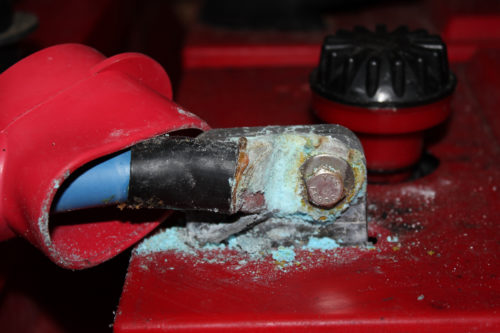 Proper installation, connection and ongoing care of your deep-cycle batteries will directly impact performance, amp-hour capacity and cycle life.
Proper installation, connection and ongoing care of your deep-cycle batteries will directly impact performance, amp-hour capacity and cycle life.
When setting up a new bank of flooded lead-acid batteries, consider installation requirements and safety. In renewable energy applications, battery banks are often housed in utility rooms or battery boxes. Flooded batteries should not be installed in a completely sealed cabinet because combustible hydrogen gas is generated during regular charging as the cell voltage reaches 2.25 VPC or above. Ventilation is necessary for all flooded battery installations and is still recommended when using sealed AGM or GEL types.
Flooded cells must be kept in an upright position at all times to prevent the electrolyte from spilling if the batteries are tilted more than 20°. Sealed AGM models offer more flexibility, typically offering the option to install the batteries on one side (not upside down). Always reference the manufacturer’s recommendations prior to installation.
To prevent overheating, it is recommended that batteries are separated 2.5 to 7.5 cm (1 to 3 in.) apart to allow for ease of maintenance and proper airflow and cooling. Excessive heat or cold temperatures will cause a reduction of the overall performance and life of your battery bank, shortening the life of your investment. In addition, flooded batteries operating in high temperatures will often require a top-up of distilled water more often, adding maintenance.
When connecting deep-cycle batteries in series to increase voltage and/or parallel to increase amp-hour capacity, the interconnect cables between each battery should be of equal length and sized proportionately to the amperage of the system. Cables should be as short as possible. Longer cables and cables of insufficient gauge will reduce system efficiency and overload capacity. Using varying lengths of cable, and cables of different gauge, across the string often results in charge imbalance and sulfation, requiring more frequent corrective equalizations.
All connections should be properly torqued and in good contact with the terminals. Following the manufacturer’s recommendations, a torque wrench should be used to properly tighten each connection. Dielectric grease should be used on each terminal to protect against corrosion and degradation.
Loose or over-tightened connections may cause high resistance or a short. This results in an unwanted voltage drop and excessive terminal heating, which often causes the terminal to melt or connecting wires to catch fire. This also increases the risk of explosion due to hydrogen off-gassing during heavy charging.
It is important to inspect, disconnect, clean and properly re-torque each connection on a regular basis as part of your maintenance routine. Loose terminal connections increase the change of spark or arching, which is a potential fire hazard. When reconnecting, each terminal connection should be greased to reduce damage and corrosion and prolong the life of the battery bank.
This installation tip was provided by Jeff Myles, marketing manager, Surette Battery Company, manufacturer of Rolls Battery





Tell Us What You Think!